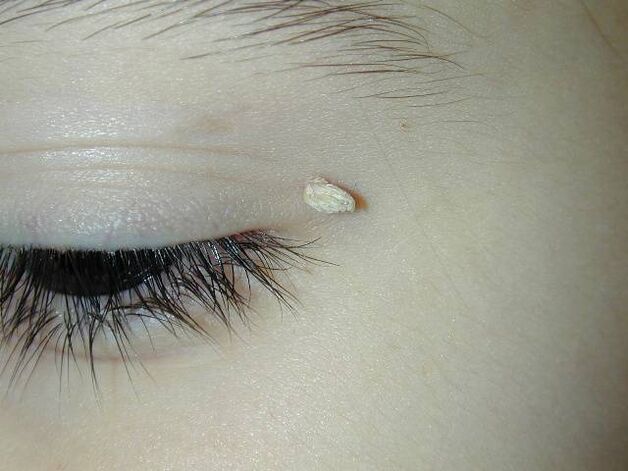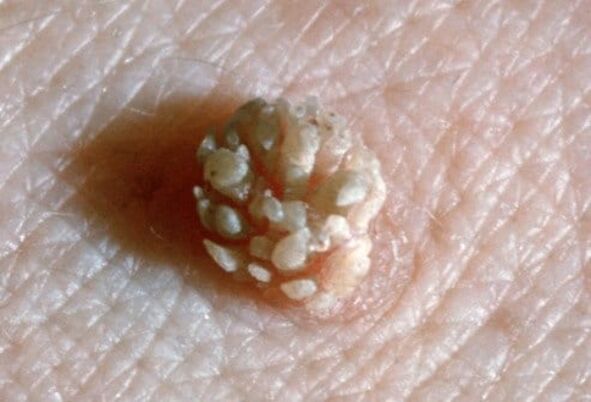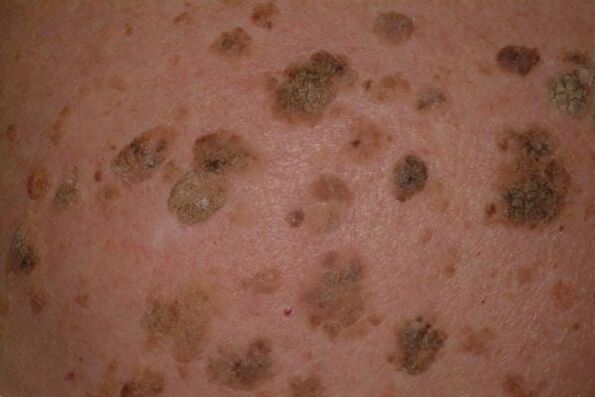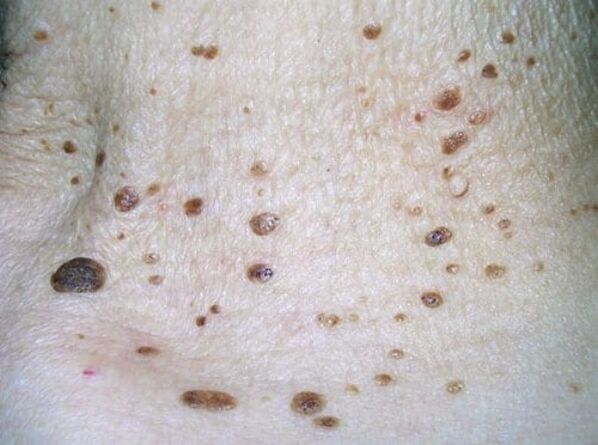About a quarter of the population suffers from problems such as warts. Someone is not paying attention to them, but someone is worried, trying to treat them. Most neoplasms do not pose a specific threat, but there are fatal (malignant) types.

Their appearance is a serious dermatological disease that has arisen as a result of human papillomavirus entering the body with weakened immunity or serious illness. The virus affects not only visible parts of the body: hands, face, feet, but also the internal systems of the body, lasting a lifetime. A person living without realizing the disease, is a carrier and, unfortunately, infects healthy people.
Today, more than a hundred types of these pathogens are known. Only people are exposed to it, so the fear of being infected by animals, especially frogs, is a myth.
What are warts?
WartsIt is a benign neoplasm of the skin caused by a virus. It develops in the form of nodules or papillae. They can be one at a time or in close groups. Spreads among children and adults with weakened immunity.
In children, there is a desire to tear or just scratch the warts, this leads to transmission of the infection to clean areas of skin. Warts behave unexpectedly: they can disappear on their own without any effect on them, or they may not be affected by the most effective medications and treatments.
Types of warts
rata
oblong plaqueup to a size of 9 mm, slightly rising above the skin. Painted in gray-yellow or yellow-pink. They form many groups. Causes itching. Externally, they resemble nettle burns. Appears on the face, neck, back of the skin of the arms and legs, female body, male. This species is not found in adults. Occurs during hormonal changes in the body.
Hence the second namejuvenile warts. Their appearance on the facial skin of young men can trigger the onset of using razors: wounds on the facial skin, neck and non -compliance with basic hygiene rules. Pass on your own.
Picture
Pictures of flat warts clearly show the characteristic features of this type:

Abusive
The most common type. It mainly affects children. Location - fingers, palms, hands, rarely appear on the mucous membranes. Growth from 0. 5 to 2 mm, flesh -colored, possibly with red spots.
Grows from maternal warts to children. This type of treatment is not required. After 3-6-8 months they disappear on their own. Several cases have been identified when the warts persist for 1. 5 years. Of course, it can be removed if it is localized on a large area of skin or causes discomfort when moving.
Picture
The picture shows the structure and location of rough warts on the fingers:

filiform
A common sight among the elderly. In rare cases, pregnant women are affected, marking problems in the course of pregnancy, also with menopause in women, because the hormonal background goes astray. In the early stages, lumps are formed, increasing in size, taking the form of threads from 5 to 10 mm flesh -colored. They can join in groups, forming shells.
They appear in the area of the eyes, nose, neck, groin, armpits, around the chest in women, that is, where there is fine skin, there are folds and places with excessive sweat. Requires careful observation of specialists, treatment. They do not go alone. It needs to be treated or removed.
Picture
The photo shows the filiform warts that hit the eyes:

Genital warts
small formationspink flesh, divided into pieces. Externally, they resemble cauliflower inflorescences. They develop on the genitals, anus, in rare cases in the oral cavity, urethra. In appearance, warts are confused with mother of pearl papules, which are not a disease.
Genital warts are soft to the touch, attached to a thin stem, can have different sizes: from 2 millimeters to 10 centimeters. They are transmitted only sexually, therefore they belong to the venereal disease of the same name. Areas with minor cracks or injuries are particularly vulnerable.
They appear 2-3 months after sexual intercourse, if immunity is very good, then the process can stretch for decades. The spread of the virus in the body can cause cervical cancer in women and penile cancer in men. Therefore, if warts of this type are found, it is important to immediately contact a doctor - a specialist: venereologist, gynecologist. Get rid of only treatment and removal.
Picture
Photo shows pointed warts (anogenital):

Senile (seborrheic keratosis)
Applies to older people.Dark brown or blackresembles melanoma (a malignant tumor), so it is important to consult an oncologist. Appears on the face, neck, body. This type of neoplasm is the only one that is not caused by the human papillomavirus. Over time, the warts become dense to the touch, covered with a keratin crust with black or white "pearls".
Location - chest, neck, face, arms. Not visible on soles of feet and palms. Its size is from 2 mm to 6 cm. Both single results and cumulative focus up to several dozen are possible. In patients with multiple seborrheic keratosis, a family history is sometimes recorded, which is a reflection of hereditary predisposition.
This species develops slowly, over decades, and does not undergo malignant transformation. They need observation and treatment. Remove as directed by doctor.
Important: with the appearance of neoplasms on the skin of the elderly, you should immediately see a dermatologist and oncologist so as not to miss the development of skin cancer!
Picture
The picture shows the four stages of development of senile warts.
Point rating:

Papular forms (nodules and papules):

Keratotics:

Skin horn:

Common localization of warts
Warts most often appear in the following places:
Facial warts:
- Flat - the most common type, affecting the cheeks, the area around the mouth.
- Vulgar - can appear on any part of the face as a single or several formations in different areas.
- Filiform - favorite places are the eyelids, lips, neck.
Warts on hands and arms:
- Vulgar - affects fingers, palms, hands (photo).
- Flat - the back of the palm, the outside of the elbow joint area, nail plate (photo).
Plantar warts.Localization - fingertips, base of fingers, feet. Plantar warts are popularly called "spikes". Appears in places of shoe pressure, especially in people who suffer from constant foot sweating. Keratin growth is yellowish gray. Appearances are observed singly, in rare cases, a group of three to five formations. Causes discomfort while walking. Passed on its own or removed by surgery, cauterization.
The cause of warts
As we already know, the source of the appearance of neoplasms is dangeroushuman papilloma virus.Infection from an infection carrier to a healthy person through household, sexual intercourse, through objects of collective use.
It is easy to infect the virus in resting places - baths, saunas, beaches, pools. Suitable for infections at night, in the evening, because sunlight harms the virus. Symptoms of the disease appear after two to five months.
Factors that contribute to the appearance of warts:
- Weak immunity.
- Synthetic shoes.
- sweating.
- Violation of metabolism in the body.
- Endocrine pathology.
- Pressure.
- Fungi and other infectious diseases.
- Inadequate hygiene.
- Lack of nutrients in the body.
- Relaxing sex.
- Not adhering to the rules of asepsis and antisepsis during manicures and pedicures.
Warts treatment at home
When the formation appears, first of all, you should seek the advice of a dermatologist. He will examine, determine the nature of the incident and the type of education. He or she will prescribe the appropriate treatment for your case. In the early stages, drug treatment is very effective.
In children
Treatment of warts in children:
- Ointment prescribed by a dermatologist. Treat the wart itself directly, after steaming it, wait for full absorption. The effects last from two weeks to two months.
- Medical plaster for the treatment of warts. It is saturated with salicylic acid. The advantage of the patch is that the affected area is covered. This does not prevent children from playing. It also prevents bacteria from entering the wound, thus blocking the further spread of the virus.
- antiviral therapy.
- Apply medicine to protect the immune system.
- Conduct a preventive vitamin course.
Tips from traditional medicine:
- Fresh juice of celandine, dandelion or garlic. Treat warts several times a day.
- Dough with vinegar essence. Mix two drops of essence with the flour. Cut a small hole in the patch, the same size as the wart. Stick to the blanks, thus protecting healthy skin areas. We put a piece of the resulting dough in the hole, fixing it on top with another small piece of plaster. It is better to perform the procedure at night. The result may be in the morning.
- Lotion from wormwood decoction.
If, after removal, a new neoplasm appears, you should think about the state of the baby's immunity. It is important to carefully consider the child's diet, devoting more time to walking in the fresh air. If the body’s defenses are functioning at full strength, knowledge of how to remove warts from children is not required. The body will be able to cope with the virus itself.
In adults
You can use chemicals from pharmacies: antiviral ointments and creams that contain alkalis or acids.
In addition, you can use:
- Phenol and meta-cresol-based caustic agents. Using an applicator, treat warts without getting healthy skin. Used to remove plantar, filiform, common warts.
- Preparation with sodium hydroxide. It is considered the best medicine. Use strictly as directed by your doctor.
- Medication with the juice of celandine grass. This medicine is not only to get rid of warts, it is also an antiviral agent.
- Spray with coolant, temperature minus 57 degrees.
- Solutions based on different acid mixtures.
- Antiviral gel containing unique synthetic peptides. Suitable for adults and children.
- A combination of polysaccharides, acetic and citric acids, potassium iodide, aromatic plant extracts and celandine. The drug has no side effects.
Wart removal
You need to start by examining the warts by a doctor, this will help to understand the cause of the incident and prevent recurrence.
Laser removal
main method. Quickly and painlessly will help eliminate the formation. Used in children since childhood. Fights all types of warts.
There are several contraindications:
- ARVI or exacerbation of chronic disease at the time of treatment;
- hypertension;
- malignant education;
- pregnancy and lactation.
High -tech surgical lasers are used for the procedure. In any neoplasm, under the high temperature action of the laser beam, the pathogen dies. The beam acts on the surface of the skin without touching or injuring it. The main advantage of this method is that the operator of the laser device can easily control the power and depth of the beam.
After the procedure, it is not recommended to wet the wound, go to the bath, sauna, swimming pool, solarium, protect from direct sunlight, do not use cosmetics, do not hide under plaster.
Treatment benefits:
- no risk of infection;
- the wound does not bleed;
- minimum time for the procedure;
- once is enough;
- methods for any type of warts;
- no age restrictions.
Removal with liquid nitrogen (cryolysis)
Wart tissue cell death occurs during the clotting process. This method is suitable for shallow keratin growth.
Contraindications:
- sensitivity to nitrogen;
- epileptic seizures;
- hypertension;
- pregnancy and first month of lactation;
- SARS and other infections.
Use a special nozzle cryoapplicator or a wooden stick with a cotton tip. impact on current education10-40 seconds. The growth turns white, within an hour a bubble appears in its place, which cannot be stabbed or cut. It will disappear on its own within a week, gradually drying out. Eventually, the effects of the treatment disappear within two to three weeks.
When treating flat warts, doctors perform skin shading: 4 approaches at 2 -minute intervals.
Treatment of plantar warts is painful, as deeper nitrogen exposure is required. For efficiency, the procedure is performed 3-4 times in four days. In severe growths, treatment is delayed for up to six months. The recovery period takes three weeks, as there is pain during healing, which causes discomfort when walking.
Advantage:
- affordable;
- short -term procedures that do not require preparation;
- the development of infection is excluded;
- does not leave scars.
Disadvantages:
- anesthesia is required;
- with inaccurate calculation of the depth of exposure, skin burns may occur.
- repeated courses for large warts.
Electrocoagulation
Special toolselectrocoagulatorproduces high frequency current. It has a tip with a loop -shaped electrode. Doctors control and regulate the current supply. Under the influence of the discharge, the cell temperature inside the wart reaches 80 degrees. They are dying. Education is cut off. The crust finally disappeared within a week.
Contraindications:
- herpes activity;
- malignant tumors or suspicion of them;
- inflammation in the procedure area;
- the location of the wart near the blood vessel.
Advantage:
- the procedure takes some time - from a few seconds to a minute;
- the ability to burn several growths at once;
- no bleeding;
- no risk of infection.
Disadvantages:
- requires anesthesia;
- damage to surrounding tissues;
- unpleasant tingling sensation after the procedure;
- daily processing of the crust;
- scars.
Excision with a scalpel
Traditional and easy way to remove. Before the procedure, the area is anesthetized, then its growth is cut with a scalpel. The wound was sutured, which was removed on the eighth day. This method is used with extensive lesions, when other methods are ineffective. Leaves scars. There is a risk of infection, hence a new focus.
Guidance:
- large size of warts;
- suspected development of malignant tumors;
- contraindications to other methods.
Minimum contraindications:
- exacerbation of herpes or other infections;
- chronic illness without additional examination;
- rejection to pregnant women at the discretion of the physician.
Prevention
Warts prevention:
- Cleanliness.
- Regular partner.
- Personal belongings.
- Vitamin therapy.
- Maintain immunity.
Developed medicine and various ways to deal with warts can not affect the complete elimination of human papillomavirus, unfortunately, its rate is increasing in all countries of the world.You cannot leave an illness unattended.Continuous monitoring by specialists and timely treatment will help prevent the risk of focal malignant transformation.















